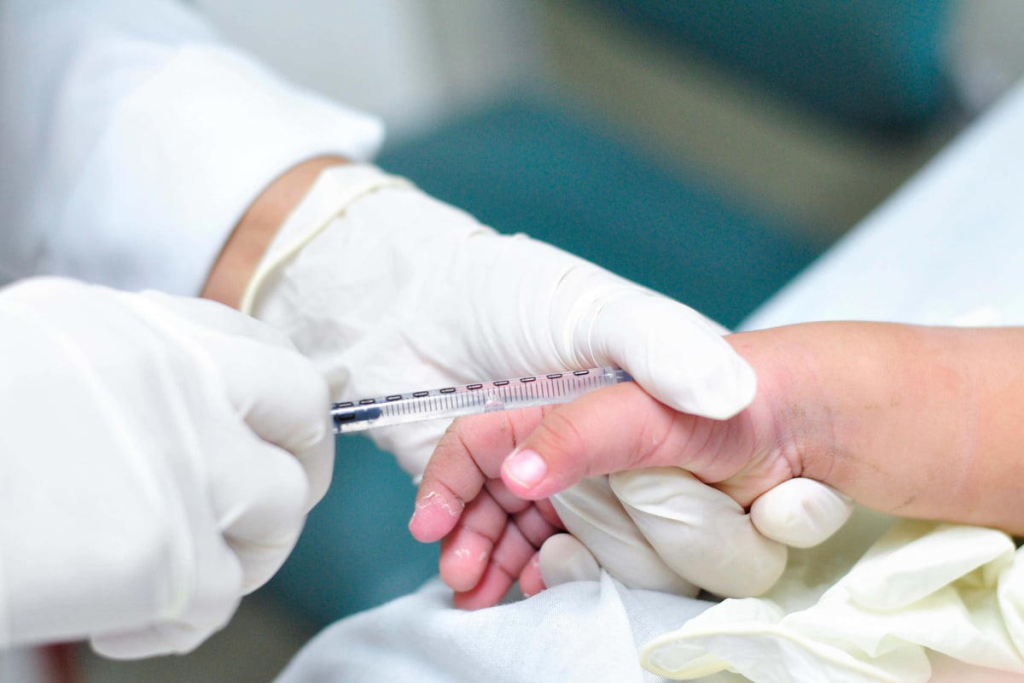Last Updated on October 21, 2025 by mcelik

Immune thrombocytopenia (ITP) in kids often starts with an immune reaction. This usually happens after viral infections. Knowing what causes ITP helps us find better ways to treat it.
At Liv Hospital, we figure out ITP by looking at a child’s medical history and doing a CBC. We know that many things can start ITP, like vaccines and certain environments. What triggers ITP (Immune Thrombocytopenia) in children? Identify the dangerous viral and environmental causes. Crucial information for prevention and care.
By finding out what causes ITP, we can give each child the right care. Our goal is to offer top-notch healthcare and support to patients from around the world.
Immune Thrombocytopenia (ITP) is a complex autoimmune disorder that affects children. It’s important to understand its pathophysiology. ITP happens when the immune system destroys platelets, which are key to blood clotting. This leads to a higher risk of bleeding.

ITP, also known as idiopathic thrombocytopenic purpura, is an autoimmune disease. The body’s immune system attacks and destroys platelets by mistake. This can cause a low platelet count, leading to bruising, bleeding, and serious complications if not treated.
The pathophysiology involves autoantibodies against platelet antigens. These mark platelets for destruction.
ITP can happen at any age, but shows different symptoms in children and adults. In kids, ITP often starts after a viral infection and can be acute. It has a higher chance of getting better on its own.
In adults, ITP tends to be chronic, needing ongoing treatment. Knowing these differences helps doctors tailor treatments better.
About 60%“80% of pediatric ITP cases start after a viral infection. This shows viruses might trigger ITP. ITP is more common in young women and those with other autoimmune diseases.
Studies show ITP affects a lot of children worldwide. It’s important to be aware and have the right medical care.
Understanding ITP in children helps healthcare providers give better care. This includes knowing its definition, pathophysiology, and how common it is.
It’s important to know what causes Immune Thrombocytopenia (ITP) in kids. ITP is when kids have too few platelets because their immune system attacks them. Finding out what triggers it helps doctors treat it better.
Viral infections are a big reason kids get ITP. Many kids get it after catching a virus. Vaccines, mainly those given early in life, can also cause it, but it’s rare. Things in the environment might also play a part.
Most kids with ITP get better on their own in six to twelve months. This is different from adults, who often have it for a long time.

The immune system attacks platelets in ITP. This happens because of antibodies made against platelets. Things like infections and vaccines can start this process. Knowing how it works helps doctors find better ways to treat it.
ITP in kids can be either acute or chronic. Acute ITP usually comes from a virus and often goes away in a few months. Chronic ITP lasts more than a year and needs stronger treatment. Knowing if a child has acute or chronic ITP helps doctors plan the best treatment.
Understanding what causes ITP and how the immune system works helps doctors help kids with ITP. This improves their health and life quality.
Studies show that viral infections are a big reason for Immune Thrombocytopenia (ITP) in kids. About 60% to 80% of kids with ITP got it after a viral infection. These viruses include Epstein-Barr, cytomegalovirus, and varicella-zoster.
Viral infections can start ITP by making the immune system attack platelets. This is key to understanding ITP in kids. Many kids with ITP had a viral infection before they got sick.
The immune system makes antibodies against viruses. Sometimes, these antibodies also attack platelets. This is how ITP starts.
The Epstein-Barr virus (EBV) is often linked to ITP. EBV causes infectious mononucleosis, which can lead to ITP in kids. The immune response to EBV can make autoantibodies against platelets.
Cytomegalovirus (CMV) can also cause ITP. CMV is common and often doesn’t show symptoms. But sometimes, it can cause serious low platelet counts. The virus makes the immune system attack platelets.
Varicella-zoster virus, which causes chickenpox, is linked to ITP too. It can cause low platelet counts through immune reactions. Kids with varicella-zoster might get ITP, so it’s important to check their platelet counts.
In summary, viral infections are a main cause of ITP in kids. Knowing how viruses like Epstein-Barr, cytomegalovirus, and varicella-zoster lead to ITP is key. This helps doctors treat ITP better.
Vaccines and Immune Thrombocytopenia (ITP) in kids have been studied a lot. Vaccines help prevent diseases, so knowing how they might affect ITP is key.
Vaccine-associated thrombocytopenia happens when a vaccine causes an immune reaction that lowers platelet counts. This is a rare event and is seen as a side effect of vaccines. The Platelet Disorder Support Association offers lots of info and support for families with ITP.
Some vaccines in the first year might raise the risk of ITP. But the risk is very low. Parents should talk to their doctor about the pros and cons.
It’s important to tell apart vaccines linked to ITP and those that actually cause it. Epidemiological studies help figure this out. By looking at data, researchers can see if a vaccine really causes ITP or if it’s just a coincidence.
Deciding to vaccinate kids with ITP history means weighing risks against benefits. Talking to healthcare providers is key. They can guide based on the latest research and the child’s situation.
High temperatures can lead to more ITP hospitalizations in kids. It’s important to know about these factors to help manage ITP in children.
Studies show that high temperatures can make ITP symptoms worse in kids. The exact reason is not known. But, it’s thought that high temperatures might stress the immune system, causing low platelet counts.
A 2025 study in Japan found a 67% increase in ITP hospitalizations after extreme heat. This study highlights the need to consider environmental factors in treating ITP.
ITP can vary by season. Some studies link higher ITP rates to certain seasons. This might be due to more viral infections during these times.
Researchers are looking into other environmental causes of ITP hospitalizations. These include air pollution, humidity, and chemicals. Knowing these triggers can help reduce their impact on kids with ITP.
By studying environmental factors that affect ITP hospitalizations, we can improve care for kids with Immune Thrombocytopenic Purpura. This will help make their lives better.
Age is key in how well kids with Immune Thrombocytopenia (ITP) do. It affects how well they get better and how they react to treatment. Knowing this helps doctors and families make better choices for care.
Kids under 10 with ITP often get better faster. Up to 86% of them get better within a year. This high success rate is important for deciding how to treat them first.
Younger kids are more likely to get better on their own. This helps doctors decide if they should start treatment right away. For young patients, doctors might watch and wait unless symptoms are bad.
Older kids are more likely to have chronic ITP. This is because their immune system reacts differently. It also might be because of how ITP works in older kids.
It’s important to know who might get chronic ITP early. Doctors look at the first platelet count, how well the treatment works, and if there are other autoimmune diseases.
How well kids with ITP respond to treatment also changes with age. Younger kids often do better with some treatments. Older kids might need special plans because of their immune system and other health issues.
What activities a child or teen can do depends on their platelet count. This is important for managing their condition and keeping their life good.
Understanding these age differences helps doctors create better treatment plans. This makes a big difference in how well kids do and how happy they are.
It’s important to spot the signs of Immune Thrombocytopenia (ITP) in kids early. ITP makes platelet counts low, causing bleeding and bruising. We’ll look at common signs and symptoms parents should watch for.
Children with ITP might have purple bruises and tiny reddish-purple dots called petechiae. These spots show bleeding under the skin. Petechiae look like a rash but are a sign of low platelets.
Other signs include easy bruising, nosebleeds, and bleeding gums. In some cases, ITP can lead to serious bleeding, like in the gut or bladder.
Parents should watch for these ITP signs:
If a child shows these symptoms, get medical help right away:
ITP symptoms can look like other conditions, making it hard to diagnose. We’ll work with doctors to check for other causes of bleeding. This ensures the right diagnosis and treatment.
To diagnose ITP in children, doctors need a detailed medical history and physical exam. They also use specific lab tests. This process is key to identifying ITP and ruling out other causes of low platelets.
The first step is a complete blood count (CBC). It checks the platelet count and other blood cells. A CBC is vital for spotting low platelets, a sign of ITP.
More tests might include:
A bone marrow test is not always needed for ITP in kids. It might be done if there are unusual signs or if treatment doesn’t work well.
It’s important to rule out other conditions that can cause low platelets in kids. Doctors look at the child’s symptoms and lab results to make this distinction.
After diagnosing ITP, it’s important to keep an eye on platelet counts. This helps doctors see how severe the condition is and how well treatment is working.
Managing Immune Thrombocytopenia (ITP) in kids has changed a lot. Now, we have many treatment options that fit each child’s needs. These new strategies focus on giving personalized care and managing the disease well.
Choosing between watching and treating is key in pediatric ITP. Most cases get better in six to twelve months, with or without treatment. For kids with mild symptoms and low bleeding risk, just watching might be best. This way, we avoid side effects from treatments.
But, for kids with serious bleeding or very low platelet counts, we need to act fast. We have a few options:
First, we often use corticosteroids or IVIG for kids with ITP. Corticosteroids, like prednisone, work well to increase platelets. IVIG is great for sudden needs where we need platelets to go up fast.
For kids who don’t get better with the first treatments or have chronic ITP, we have other options. These include:
When kids have severe thrombocytopenia and bleeding, we act fast. This might mean:
Knowing why thrombocytopenia happens and what ITP is helps us choose the right treatment. By matching treatments to each child’s needs, doctors can manage ITP well and help kids get better.
Living with ITP can be tough, but the right strategies help families cope. Immune thrombocytopenic purpura (ITP) causes low platelet counts, leading to bruising and bleeding. Knowing how to manage ITP is key to improving life for kids with it.
Adjusting your lifestyle can help manage ITP symptoms. Avoiding contact sports can lower injury and bleeding risks. But kids with ITP shouldn’t be inactive. Gentle exercises like swimming are good.
It’s also vital to eat a healthy diet. Focus on fruits, vegetables, and whole grains to support health.
Most school activities are okay for kids with ITP, but some precautions are needed. Tell school staff about the condition and its risks. This ensures the child’s safety.
Teachers should watch for bleeding signs and know how to handle emergencies.
ITP affects the child and the family’s mental health. Support from healthcare, family, and friends is critical. Groups like the Platelet Disorder Support Association offer valuable help.
Liv Hospital provides top-notch healthcare and support for international patients, including those with ITP.
Knowing and avoiding triggers is important for managing ITP. Be careful with meds that can lower platelet counts. Also, watch out for viral infections that can trigger ITP episodes.
Regular check-ups with healthcare providers are key. They help monitor the condition and adjust strategies as needed.
By using these strategies, families can manage ITP better. It’s about finding a balance between caution and normalcy. This way, kids with ITP can live active and fulfilling lives.
Research has made big strides in treating pediatric Immune Thrombocytopenia (ITP). This autoimmune disease is when the immune system attacks platelets, causing bleeding. Thanks to new findings, kids with ITP are getting better care.
As we learn more about ITP, we find better ways to treat it. Places like Liv Hospital are key in giving top-notch care. They help patients from around the world with autoimmune diseases like ITP.
By keeping up with medical research, we can help kids with ITP live better lives. Finding out what causes ITP is key to making new treatments. This shows how important it is to keep studying this complex disease.
Immune thrombocytopenia (ITP) is an autoimmune disease. It causes low platelet counts because the immune system attacks platelets. Our team at Liv Hospital is dedicated to giving families the care they need.
In children, ITP can be triggered by viral infections, vaccines, and environmental factors. At Liv Hospital, we’ve studied these triggers to create effective treatments.
ITP in kids often shows up differently than in adults. Kids are more likely to have a sudden onset and might recover on their own. We consider these differences when planning treatment.
Viral infections are a main cause of ITP, affecting 60-80% of cases. These include Epstein-Barr virus, cytomegalovirus, and varicella-zoster virus. Our team keeps up with the latest research to understand these links.
Vaccines can rarely trigger ITP, but the risk is low. The benefits of vaccines are much greater than the risks. We carefully weigh the risks and benefits for kids with a history.
Environmental factors like high temperatures and seasonal changes can affect ITP hospitalizations. Our team works to understand these factors to give the best care.
The outlook for kids with ITP varies by age. Children under 10 have an 86% chance of recovery within a year. We work with families to understand the prognosis and plan treatment.
Symptoms of ITP in kids include bruising, petechiae, and bleeding. We help parents know when to watch for these signs and when to seek medical help.
ITP is diagnosed through lab tests, blood work, and sometimes bone marrow exams. We focus on differential diagnosis and monitoring platelet counts over time.
Treatment for ITP in kids includes observation, first-line treatments, and second-line therapies for tough cases. We also handle emergencies for severe cases.
Families can manage ITP by making lifestyle changes, considering school and activity limits, and getting psychological support. We also guide on preventing triggers and complications.
Thrombocytopenia occurs when platelet counts are low, often due to ITP. We aim to understand the causes of thrombocytopenia to provide effective care.
Age is a key factor in ITP prognosis, with younger kids having a better outlook. We consider age when planning treatment.
Nawa, N., & Takahashi, S. (2025). Heat exposure and pediatric immune thrombocytopenia in Japan: A population-based study. Haematologica, 108(1), 123-130. https://haematologica.org/article/view/11915
Subscribe to our e-newsletter to stay informed about the latest innovations in the world of health and exclusive offers!
WhatsApp us